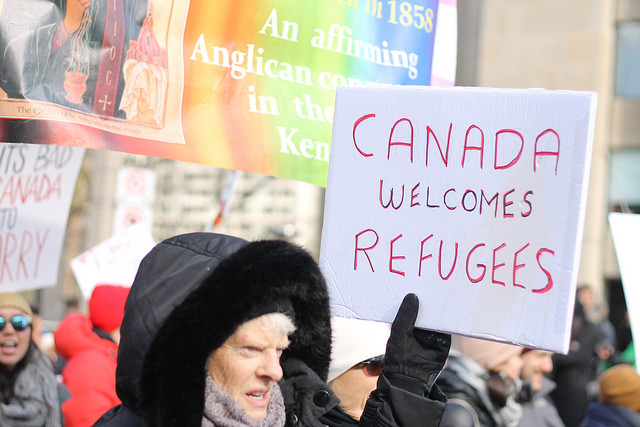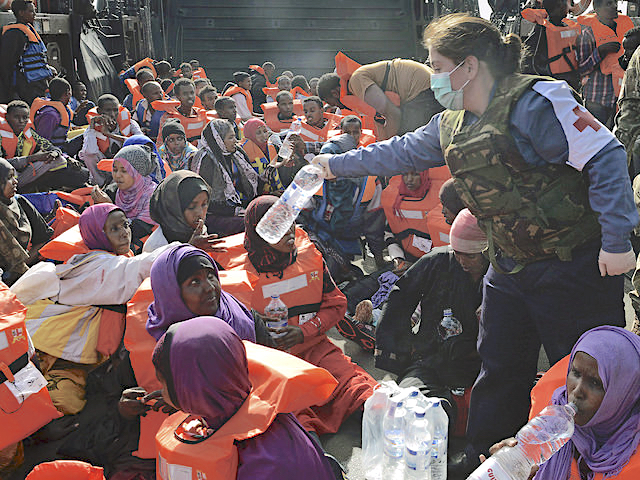Following Trump’s executive order, Canadians stepped up calls to revoke an agreement designating the U.S. a safe country for asylum seekers. Oxford University’s Cory Rodgers examines how such ‘safe country’ agreements can put asylum seekers at risk.
Following Donald Trump’s executive order on refugees, thousands of Canadians signed a petition urging Prime Minister Justin Trudeau to cancel the U.S.-Canada Safe Third Country Agreement. The 2005 agreement allows Canadian border patrol to turn back asylum seekers entering from the United States on the basis that they are already present in a safe country.
“Except remaining in Trump’s America is unsafe,” the petitioners write, noting the U.S. president’s suspension of refugee resettlement and his pledge to deport undocumented immigrants.
But this argument does not go far enough in its criticism of the 2005 agreement. Debates about whether the U.S. qualifies as “safe” overlook how the very notion of a “safe third county” can put asylum seekers at risk.
Safe third country (STC) rules – nicknamed “protection elsewhere” policies by Michelle Foster, director of the International Refugee Law Research Program at Melbourne Law School – allow governments to reject entry to asylum seekers without violating international law, so long as they are being turned back to a country that is deemed “safe.”
Yet these rules can put refugees and migrants in danger if so-called “safe” countries are ill-equipped to take in returning refugees. And if asylum seekers don’t feel safe, they may try to take even riskier routes to reach safety. More broadly, STC rules can normalize policies that shift rather than share responsibilities toward asylum seekers.
Out in the Cold
During the winter cold months, the impact of such policies is painfully visible, both in North America and in Europe.
Even before Trump’s inauguration, one Canada-U.S. border checkpoint in Manitoba reported that over the course of eight months, 410 asylum seekers had been intercepted while crossing the border by foot to circumvent the STC agreement. The journey is especially dangerous in the winter, as evidenced when two Ghanaian men were rescued near the border with severe frostbite injuries.
In Europe, asylum seekers trying to head north have bottlenecked in Serbia, seeking shelter in abandoned buildings in Belgrade where nighttime temperatures have sometimes reached minus 16C (3.2F). Others have been beaten and abused by police and unofficial civil militias as they try to cross the border into Hungary.
Why would asylum seekers want to move from one safe country to another, braving the cold in transit camps and dangerous overland journeys to do so?
Reasons vary, but one factor is that not all asylum systems are equal. In North America, for example, asylum claims in Canada take an average of two months while those in the U.S. can last as long as five years, according to Mariah Walker, who works for the New York-based nonprofit Jericho Road Community Health Center. If someone doesn’t want to live in legal limbo for years awaiting the protection afforded by official refugee status, the efficiency of Canada’s asylum system is an obvious draw.
There are some exceptions to the U.S.-Canada STC agreement, including people who have family connections in Canada and unaccompanied minors. Jericho Road Community Health Center provides shelter and legal advice to asylum seekers in Buffalo, N.Y., as they await their interviews with Canadian border patrol, usually granted after a three-week wait. If determined to be exempt, they may enter Canada to make an asylum claim. If not, they must return to the U.S., although some decide to try to circumvent border control on foot.
In Europe, the situation is more complicated. Most asylum seekers first arrive in southern Europe, but try to continue northward in an attempt to reach countries with better reception conditions, more efficient asylum processes, more favorable acceptance rates and better protection services and integration support, notes Andras Lederer, advocacy officer at the Hungarian Helsinki Committee. As transit camps fill and E.U. countries introduce new application conditions, people may choose a different destination or change course.
Asylum seekers who reach Europe face various bilateral and multilateral arrangements attempting to contain them in the first “safe” country where they arrive. Any country can apply STC rules, which requires migrants to prove that they did not already transit a safe country with a functioning asylum system. Countries within the E.U. also apply the Dublin Regulation, a multilateral agreement providing criteria to determine which member state is responsible for a given asylum case – usually the country of arrival – and specifies procedures for making transfers. Both the STC rule and the Dublin Regulation serve the same function: shifting responsibility for asylum seekers elsewhere.
Hungary’s Strategy
For example, migrants in Serbia, a non-E.U. country, hoping to join families in northern Europe or avoid dire conditions in Greece, may try to cross into neighboring E.U. countries Croatia or Hungary. A combination of STC rules, the Dublin Regulation and illegal pushbacks block them from doing so.
According to Lederer, Hungary’s strategy for restricting access until last year was to declare migrants inadmissible under the STC rule. Despite the deplorable conditions facing asylum seekers in Serbian camps, Serbia was included on a list of “safe” countries compiled by the Hungarian government, so those arriving from Serbia were barred from entering or applying for asylum in Hungary.
In late autumn 2016, Hungary’s Immigration and Asylum Office stopped rejecting people based on the STC rule and instead began applying the Dublin Regulation, says Lederer. Under this rule, rather than return people to Serbia, which is not a member of the E.U., Hungary can transfer asylum seekers to other E.U. countries through which they have previously transited on the way to Hungary, like Greece, Bulgaria, Romania or Croatia. It’s not yet clear how many people have been transferred under this policy.
Many northern countries suspended returns to Greece under the Dublin Regulation in 2015 due to poor conditions in the country’s overburdened camps. Germany recently announced its intention to recommence returns starting in March. Experts at the Migration Policy Institute noted in an email interview that this move could cause a spike in irregular migration and human smuggling. Only those who arrive in Germany after the policy change would be subject to returns, a condition that may encourage attempts to reach Germany before that date, by whatever means available.
Some countries have stepped outside the bounds of international law in their efforts to restrict entry for asylum seekers, setting daily quotas on asylum applications or forcibly pushing migrants beyond their borders. These governments often point to the extenuating circumstances of “the refugee crisis,” drawing on popular fears of terrorism, economic collapse and cultural change to justify their actions.
The STC rule, insofar as it acknowledges obligations under the 1951 Refugee Convention, may seem like a welcome alternative to the blatant disregard for international law expressed by nativist politicians like Hungarian Prime Minister Viktor Orban. Yet the underlying danger of the safe country principle is that if accepted in times of calm, it can normalize the practice of restricting border access and shifting responsibility that then becomes rampant in a crisis.
Calls for Repeal and Reform
As activists call for a repeal of the U.S.-Canada Safe Third Country Agreement, Europe’s asylum process is also facing mounting calls for reform.
As evident from the backlog of migrants in Greece and Italy, the Common European Asylum System set up in 2005 has failed to provide thousands of people with access to a fair and efficient asylum application process. Key to this failure is the Dublin Regulation, placing the bulk of responsibility for asylum seekers on countries along the Mediterranean where most first arrive.
U.N. High Commissioner for Refugees Filippo Grandi in December 2016 called for a major overhaul of the European asylum system. He recommended simplifying the asylum process – developing a uniform set of procedures for all E.U. countries – and reforming the Dublin Regulation to share human rights obligations more equitably across countries.
In North America, calls to repeal the U.S.-Canada Safe Third Country Agreement are an important response to the new Trump administration’s policies. But the principle enshrined in this agreement is also at play more broadly in other contexts, and we should continue to scrutinize the appropriateness of shifting rather than sharing the burden of asylum claims.
Successful reform – in both Europe and North America – will require policymakers to acknowledge that the refugee problem is not so much a crisis of human mobility, but a crisis of responsibility.
This article originally appeared on Refugees Deeply, and you can find the original here. For important news about displacement and forced migration, you can sign up to the Refugees Deeply email list. Photograph courtesy of Stacie DaPonte. Published under a Creative Commons license.





